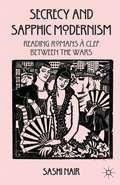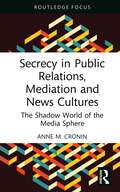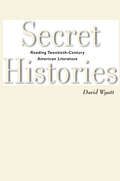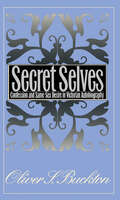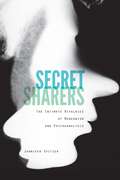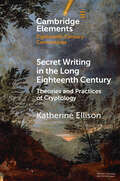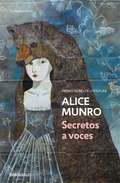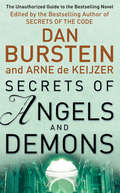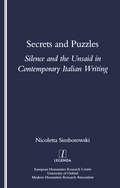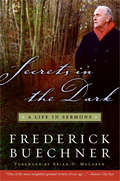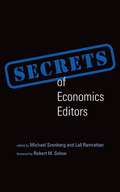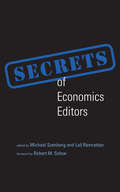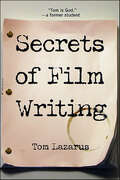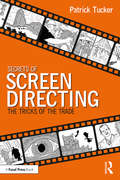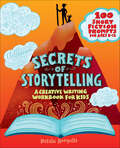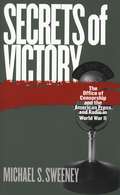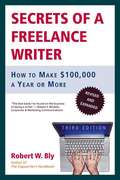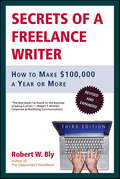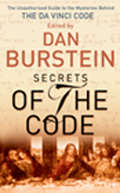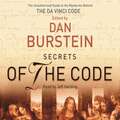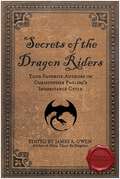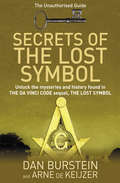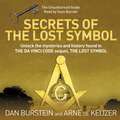- Table View
- List View
Secrecy and Sapphic Modernism
by Sashi NairNovels by significant Modernist authors can be described as romans à clef , providing insight into restrictions governing the representation of female homosexuality in the early twentieth century. Nair argues that key novels of the period represented same-sex desire through the encryption of personal references directed towards coterie audiences.
Secrecy in Public Relations, Mediation and News Cultures: The Shadow World of the Media Sphere (Routledge Focus on Media and Cultural Studies)
by Anne M. CroninThis book investigates the relationship of secrecy as a social practice to contemporary media, news cultures and public relations. Drawing on Georg Simmel’s theorisation of how secrecy produces a ‘second world’ alongside the ‘obvious world’ and creates and reshapes social relations, Anne Cronin argues for close analysis of the PR industry as a powerful vector of secrecy and an examination of its relationship to news cultures. Using case studies and in-depth interviews, as well as recent research in media and cultural studies, sociology, journalism studies and communication studies, the book analyses how PR practices generate a second, shadow world of the media sphere which has a profound impact on the ‘obvious world’. It interrogates both the PR industry’s and news culture’s role in shaping social relations for a digital media landscape, and those initiatives promoting transparency of data and decision-making processes. An insightful, interdisciplinary approach to debates on media and power, this book will appeal to students of public relations, sociology, media studies, cultural studies and communication studies. It will also be of interest to scholars and practitioners working at the intersections of media, social relations and public trust.
Secret Histories: Reading Twentieth-Century American Literature
by David WyattSecret Histories claims that the history of the nation is hidden—in plain sight—within the pages of twentieth-century American literature. David Wyatt argues that the nation's fiction and nonfiction expose a "secret history" that cuts beneath the "straight histories" of our official accounts. And it does so by revealing personal stories of love, work, family, war, and interracial romance as they were lived out across the decades of the twentieth century. Wyatt reads authors both familiar and neglected, examining "double consciousness" in the post–Civil War era through works by Charles W. Chesnutt, W. E. B. Du Bois, and Booker T. Washington. He reveals aspects of the Depression in the fiction of F. Scott Fitzgerald, Anzia Yezierska, and John Steinbeck. Period by period, Wyatt's nuanced readings recover the felt sense of life as it was lived, opening surprising dimensions of the critical issues of a given time. The rise of the women's movement, for example, is revivified in new appraisals of works by Eudora Welty, Ann Petry, and Mary McCarthy.Running through the examination of individual works and times is Wyatt's argument about reading itself. Reading is not a passive activity but an empathetic act of cocreation, what Faulkner calls "overpassing to love." Empathetic reading recognizes and relives the emotional, cultural, and political dimensions of an individual and collective past. And discovering a usable American past, as Wyatt shows, enables us to confront the urgencies of our present moment.
Secret Selves: Confession and Same-Sex Desire in Victorian Autobiography
by Oliver S. BucktonFocusing on the representation of same-sex desire in Victorian autobiographical writing, Oliver Buckton offers significant new readings of works by some of the most influential figures in late-nineteenth-century literature and culture. Combining original research, careful historical analysis, and contemporary theories of autobiography, gender, and sexual identity, he provides nuanced studies of confessional narratives by Edward Carpenter, John Henry Newman, John Addington Symonds, Oscar Wilde, and, in an epilogue, E. M. Forster. By examining the "confessional" elements of these writings, Buckton brings "secrecy" into focus as a central and productive component of autobiographical discourse. He challenges the conventional view of secrecy as the suppression of information, instead using the term to suggest an oscillation between authorial self-disclosure and silence or reserve--a strategy for arousing the reader's interest and establishing a relation based on shared knowledge while deferring or displacing the revelation of potentially incriminating and scandalous desires. Though theirdisclosures of same-sex desire jeopardized the cultural privilege granted these writers by Victorian codes of authorship and masculinity, their use of secrecy, Buckton shows, allowed them to protect themselves from Victorian stigma and to challenge prevailing constructions of sexual identity.Originally published in 1998.A UNC Press Enduring Edition -- UNC Press Enduring Editions use the latest in digital technology to make available again books from our distinguished backlist that were previously out of print. These editions are published unaltered from the original, and are presented in affordable paperback formats, bringing readers both historical and cultural value.
Secret Sharers: The Intimate Rivalries of Modernism and Psychoanalysis
by Jennifer SpitzerSecret Sharers traces a genealogy of secret sharing between literary modernism and psychoanalysis, focusing on the productive entanglements and intense competitive rivalries that helped shape Anglo-American modernism as a field. As Jennifer Spitzer reveals, such rivalries played out in explicit criticism, inventive misreadings, and revisions of Freudian forms—from D. H. Lawrence’s re-descriptions of the unconscious to Vladimir Nabokov’s parodies of the psychoanalytic case study. While some modernists engaged directly with Freud and Freudian psychoanalysis with unmistakable rivalry and critique, others wrestled in more complex ways with Freud’s legacy. The key protagonists of this study—D. H. Lawrence, Virginia Woolf, W. H. Auden, and Vladimir Nabokov—are noteworthy for the way they engaged with, popularized, and revised the terms of Freudian psychoanalysis, while also struggling with it as an encroaching discourse. Modernists read psychoanalysis, misread psychoanalysis, and sometimes refused to read it altogether, while expressing anxiety about being read by psychoanalysis—subjecting themselves and their art to psychoanalytic interpretations.As analysts, such as Freud, Ernest Jones, and Alfred Kuttner, turned to literature and art to illustrate psychoanalytic theories, modernists sought to counter such reductive narratives by envisioning competing formulations of the relationship between literature and psychic life. Modernists often expressed ambivalence about the probing, symptomatic style of psychoanalytic interpretation and responded with a re-doubling of arguments for aesthetic autonomy, formal self-consciousness, and amateurism. Secret Sharers reveals how modernists transformed the hermeneutic and diagnostic priorities of psychoanalysis into novel aesthetic strategies and distinctive modes of epistemological and critical engagement. In reassessing the historical and intellectual legacies of modernism, this book suggests that modernist responses to psychoanalytic criticism anticipate more recent critical debates about the value of “symptomatic” reading and the “hermeneutics of suspicion.”
Secret Writing in the Long Eighteenth Century: Theories and Practices of Cryptology (Elements in Eighteenth-Century Connections)
by Katherine EllisonCryptology of the long eighteenth century became an explicit discipline of secrecy. Theorized in pedagogical texts that reached wide audiences, multimodal methods of secret writing during the period in England promoted algorithmic literacy, introducing reading practices like discernment, separation, recombination, and pattern recognition. In composition, secret writing manipulated materials and inspired new technologies in instrumentation, computation, word processing, and storage. Cryptology also revealed the visual habits of print and the observational consequences of increasing standardization in writing, challenging the relationship between print and script. Secret writing served not only military strategists and politicians; it gained popularity with everyday readers as a pleasurable cognitive activity for personal improvement and as an alternative way of thinking about secrecy and literacy.
Secretaries of the Moon: The Letters of Wallace Stevens and José Rodriguez Feo
by Alan Filreis Beverly CoyleThe letter from Jose Rodriguez Feo that prompted Stevens's poem was the third in a ten-year correspondence (1944-54) between the poet and the young Cuban, who quickly became Stevens's "most exciting correspondent." The two shared a Harvard education, both were anxious to see Stevens translated for a Cuban audience, and each had an enduring admiration for Santayana, whose awareness of the cultural tensions between the Northern and Southern hemispheres formed a basis for the protracted argument between Stevens as the practical, Protestant father and the passionate Rodriguez Feo. The Cuban's descriptions of his life at the Villa Olga, of his black-and-white cow Lucera and his mule Pompilio, delighted Stevens, as did his wide-ranging questions and pronouncements of literary matters. Unaware of the well-known Stevens reticence, Rodriguz Feo elicited a more informal, playful response than Stevens's other correspondents. Formal salutations soon gave way to "Dear Antillean," "Dear Wallachio."Coyle and Filreis present the entire extant correspondence between the two men. The fifty-one Rodriguez Feo letters and ten of the numerous Stevens letters are printed here for the first time, and the exchange between the two is unusually complete. The work includes a critical introduction and complete annotation of the letters.
Secretos a voces
by Alice MunroUn libro que reúne ocho relatos de la Premio Nobel de Literatura 2013 Alice Munro. Secretos a voces reúne ocho relatos en los que Alice Munro recupera las preocupaciones y las paradojas que tanto caracterizan a sus personajes. Cada uno de estos relatos contiene más de una historia, que deja entrever escenas de la vida cotidiana llenas de dramatismo. Todos ellos transcurren en la pequeña ciudad canadiense de Carstairs, a pesar de que algunos se remonten a un tiempo y a una tierra lejana. Desde 1850 hasta el día de hoy -pasando por dos guerras mundiales- y desde Canadá hasta Australia, los Balcanes o el norte de Francia, estas conmovedoras y sobrecogedoras historias revelan los secretos de mujeres poco convencionales que se resisten a que sus voces queden reducidas al olvido. Reseña:«Deslumbrante por su fe en el lenguaje y en la vida.»The New York Times Book Review
Secrets Of Angels And Demons
by Dan Burstein Arne de KeijzerThe first book to help you understand the mysteries and secret histories within the plot of Dan Brown's bestselling ANGELS AND DEMONS.SECRETS OF ANGELS AND DEMONS provides the curious reader with concise, authoritative explorations of the major themes that help propel the plot of Dan Brown's new bestseller, ANGELS AND DEMONS. Taking the same detailed approach as SECRETS OF THE CODE, Burstein and de Keijzer examine the provocative issues raised in the novel: the existence and scope of the Illuminati and their relationship to other 'secret societies'; the ongoing, centuries-old debate between science and religion; the history and practices of the Vatican and pagan symbolism and its place within the Church. They also explore the world of Bernini, master artist of the Baroque era, and the secret meanings behind his symbolism; what really happened in the trial of Galileo; and the real state-of-the-art of anti-matter technology. This book will delight and engage everyone who finished ANGELS AND DEMONS thinking, 'I need to know more about this book'.
Secrets and Puzzles: Silence and the Unsaid in Contemporary Italian Writing
by Nicoletta Simborowski"Four major Italian writers raised in the shadow of fascism - Cesare Pavese, Primo Levi, Natalia Ginzburg and Francesca Sanvitale - are the focus of this examination of the 'unsaid' in modern Italian narrative. Post-war and free of official censorship, these writers nonetheless show signs of constraint and omission in their work. Are the gaps a form of concealment? In this lucid and wide-ranging study, which embraces key areas of modern literary investigation - Holocaust writing, political guilt, autobiography, feminism and film theory - the author addresses the question of self-censorship and traces its course in contemporary Italian writing."
Secrets in the Dark: A Life in Sermons
by Frederick BuechnerFrederick Buechner has long been a kindred spirit to those who find elements of doubt as constant companions on their journey of faith. He is a passionate writer and preacher who can alter lives with a simple phrase. Buechner's words, both written and spoken, have the power to revolutionize and revitalize belief and faith. He reveals the presence of God in the midst of daily life. He faces and embraces difficult questions and doubt as essential components of our lives, rather than as enemies that destroy us. "Listen to your life!" is his clarion call. This theme pervades this definitive collection of sermons, delivered throughout Buechner's lifetime. Presented chronologically, they provide a clear picture of the development of his theology and thinking. Reflecting Buechner's exquisite gift for storytelling and his compassionate pastor's heart, Secrets in the Dark will inspire laughter, hope, and bring great solace. Turn the pages and rediscover what it means to be thoughtful about faith. See why this renowned writer has been quoted in countless pulpits and beloved by Americans for generations.
Secrets of Economics Editors
by Michael Szenberg Lall Ramrattan Robert M. SolowEditors of academic journals are often the top scholars in their fields. They are charged with managing the flow of hundreds of manuscripts each year -- from submission to review to rejection or acceptance -- all while continuing their own scholarly pursuits. Tenure decisions often turn on who has published what in which journals, but editors can accept only a fraction of the papers submitted. In this book, past and present editors of economics journals discuss navigating the world of academic journals. Their contributions offer essential reading for anyone who has ever submitted a paper, served as a referee or associate editor, edited a journal -- or read an article and wondered why it was published. The editors describe their experiences at journals that range from the American Economic Review to the Journal of Sports Economics. The issues they examine include late referee reports, slow resubmission of manuscripts, and plagiarism -- as well as the difficulties of "herding cats" and the benefits of husband-wife editorial partnerships. They consider the role of the editor, as gatekeeper or developer of content; and they advise authors to write more carefully and clearly, to include citations that locate their articles in the context of the existing literature, and to update their work after it has been submitted and rejected elsewhere. The chapters also offer a timely, insider's perspective on the general effectiveness of the system of academic journals in economics. ContributorsRichard V. Adkisson, Richard G. Anderson, William A. Barnett, Suzanne R. Becker, William R. Becker, Daniel W. Bromley, William G. Dewald, Antony W. Dnes, Zvi Eckstein, Richard Friberg, Esther Gal-Or, Craufurd Goodwin, Thorvaldur Gylfason, Campbell R. Harvey, Geoffrey M. Hodgson, Leo H. Kahane, R. Preston McAfee, John Pencavel, Gerald Pfann, Steven Pressman, Lall B. Ramrattan, J. Barkley Rosser Jr., Paul H. Rubin, William F. Shughart II, Robert M. Solow, Daniel F. Spulber, Michael Szenberg, Timothy Taylor, Abu N.M. Wahid, Michael Watts, Lawrence J. White, Jürgen von Hagen, Fabrizio Zilibotti
Secrets of Economics Editors (The\mit Press Ser.)
by Michael Szenberg Lall RamrattanExperienced economics editors discuss navigating the world of scholarly journals, with details on submission, reviews, acceptance, rejection, and editorial policy.Editors of academic journals are often the top scholars in their fields. They are charged with managing the flow of hundreds of manuscripts each year—from submission to review to rejection or acceptance—all while continuing their own scholarly pursuits. Tenure decisions often turn on who has published what in which journals, but editors can accept only a fraction of the papers submitted. In this book, past and present editors of economics journals discuss navigating the world of academic journals. Their contributions offer essential reading for anyone who has ever submitted a paper, served as a referee or associate editor, edited a journal—or read an article and wondered why it was published.The editors describe their experiences at journals that range from the American Economic Review to the Journal of Sports Economics. The issues they examine include late referee reports, slow resubmission of manuscripts, and plagiarism—as well as the difficulties of “herding cats” and the benefits of husband-wife editorial partnerships. They consider the role of the editor, as gatekeeper or developer of content; and they advise authors to write more carefully and clearly, to include citations that locate their articles in the context of the existing literature, and to update their work after it has been submitted and rejected elsewhere. The chapters also offer a timely, insider's perspective on the general effectiveness of the system of academic journals in economics. ContributorsRichard V. Adkisson, Richard G. Anderson, William A. Barnett, Suzanne R. Becker, William R. Becker, Daniel W. Bromley, William G. Dewald, Antony W. Dnes, Zvi Eckstein, Richard Friberg, Esther Gal-Or, Craufurd Goodwin, Thorvaldur Gylfason, Campbell R. Harvey, Geoffrey M. Hodgson, Leo H. Kahane, R. Preston McAfee, John Pencavel, Gerald Pfann, Steven Pressman, Lall B. Ramrattan, J. Barkley Rosser Jr., Paul H. Rubin, William F. Shughart II, Robert M. Solow, Daniel F. Spulber, Michael Szenberg, Timothy Taylor, Abu N.M. Wahid, Michael Watts, Lawrence J. White, Jürgen von Hagen, Fabrizio Zilibotti
Secrets of Film Writing
by Tom LazarusMost books about screenplays instruct on three-act structure, character arcs, and how to format a script. But you already know all that.Secrets of Film Writing reveals a working writer's secrets-the tips, short cuts, tricks, and insider advice that will get your story down on paper, maximize your idea, and seduce your readers. Do you know why actors pick scripts out of a stack? Why montage sequences don't work? Why the traditional three-act structure is obsolete? Lazarus lifts the veil with dozens of secrets like these.Lazarus's insights and techniques will smooth and improve any screenwriter's process and will make any script more readable and ultimately more salable. Secrets of Film Writing takes you behind the scenes of feature and television writing and demystifies, once and for all, the Hollywood System.
Secrets of Inferno
by Dan Burstein Arne De KeijzerSECRETS OF INFERNO is a reader's guide to the journey Dan Brown took us all on in INFERNO. The book gives readers the "back story" on particular plot points, Dante references, symbols, historical events, philosophy, art, music, and architectural works that Brown wrapped into his story. It is also an intellectually enriching, intriguing, fresh and fun look at Dante, THE DIVINE COMEDY, the world of ideas circulating in Florence on the cusp of the Renaissance, and the relevance of those ideas to our lives and our world today.Dan Burstein and Arne de Keijzer are the world's leading experts on Dan Brown's fiction. Beginning with their path-breaking SECRETS OF THE CODE, which spent six months on the New York Times bestseller list in 2004, and continuing through four other guidebooks to Dan Brown's fiction (as well as three film documentaries and two special editions of US News), Burstein and de Keijzer have sold more than three million copies of Dan Brown-related commentaries in more than thirty languages. In the wake of each Dan Brown title over the last decade, the media (from the History Channel to CNN to MSNBC to USA Today to the Washington Post) have turned to Burstein and de Keijzer for interpretations of Dan Brown's books, decoding of the hidden symbols and ciphers, explanations of the controversies, and thoughtful separation of fact from fiction in these supremely popular stories that somehow always manage to fascinate our culture well beyond the bounds of their pop fiction genre.The ultimate guide for any Dan Brown fan, SECRETS OF INFERNO is entertaining, thought-provoking, and will make the experience of reading INFERNO richer than you ever imagined.Contributors include: Teodolinda Barolini, Da Ponte Professor of Italian, Columbia University Steven Botterill, Associate Professor of Italian Studies, University of California, Berkeley Jamais Cascio, Distinguished Fellow, Institute for the Future and Senior Fellow, Institute for Ethics and Emerging Technologies Joel E. Cohen, Abby Rockefeller Mauzé Professor of Populations at The Rockefeller University and Professor of Populations at the Earth Institute of Columbia University William Cook, Distinguished Teaching Professor of History (Emeritus), State University of New York, Geneseo Alison Cornish, Professor of Italian, Romance Languages, and Literatures department, University of Michigan Paul Ehrlich, Bing Professor of Population Studies, Stanford University, president of Stanford's Center for Conservation Biology, and author of The Population Bomb Glenn W. Erickson, Professor of Philosophy, Universidade Federal do Rio Grande do Norte (Brazil) Laurie Garrett, Senior Fellow for Global Health, Council on Foreign Relations and author of The Coming Plague Cheryl Helm, Dan Brown codes and puzzles expert Giuseppe Mazzotta, Sterling Professor of Humanities for Italian, Yale University Julie O'Connor, Fine art photographer and photojournalist David Orban, Futurist, CEO of Dotsub, and former chairman of Humanity+ David A. Shugarts, Investigative reporter, author of Secrets of the Widow's Son, and contributing editor to the Secrets series Gregory Stock, Biophysicist, biotech entrepreneur, and founding director of the Program on Medicine, Technology and Society at UCLA's School of Medicine Natasha Vita-More, Chairman, Board of Directors of Humanity+ and author of the "TranshumanistManifesto"
Secrets of Screen Directing: The Tricks of the Trade
by Patrick TuckerSecrets of Screen Directing: The Tricks of the Trade is a practical guide which bridges the gap between classroom learning and the realities of being on a set. Author Patrick Tucker uses insights and techniques gained from over 40 years of directing both screen and stage to open up the craft of effectively telling stories, exploring the reality of a directing career with practical day to day solutions and problem-solving methods for working directors. This book addresses the fact that most professional directors spend their careers directing other writers’ scripts, and deals with the practicalities of working on continuing dramas. Following the Director’s mantra of ‘show, not tell’ it contains over 300 illustrations, diagrams, paperwork examples and floor plans, with lists and charts throughout. Covering planning, preparation, and shooting a project, it delves beyond just script construction and into the nuts and bolts of screen directing. Directors at any level are always under huge time constraints, and this book provides immediate and simple solutions to working under such restrictions. This is an ideal resource for filmmaking students and early career directors to refer to when encountering a problem, as well as all those screen enthusiasts, actors and writers, who want to know what directors actually do.
Secrets of Storytelling: A Creative Writing Workbook for Kids
by Natalie RompellaMaster the magic of storytelling—100 creative, short fiction prompts for writers age 8 to 12Whether you're just getting started or you've already written a ton of stories, practice makes perfect when it comes to writing for kids. Build your skills the fun way with Secrets of Storytelling; it's packed with dozens of short, creative fiction prompts and plenty of space so you can write to your heart's content.Don't be afraid to think outside the box, make mistakes, and get weird with words! Prompts and fun activities about writing for kids inspire you to get creative and help you build intriguing plots, strong characters, and vivid settings for your stories. It's time to unleash your inner author! All books about writing for kids should include:Fun activities—Explore engaging exercises that get your creativity flowing, including brainstorming, filling in the blanks, and beyond.Tips on writing for kids—Learn simple strategies for crafting strong storylines, and get pointers for overcoming writer's block, editing your work, and more.Quotes for creativity—Discover inspirational and motivational quotes from famous writers.Step up your storytelling skills with the short, creative fiction prompts and fun activities inside this book about writing for kids. This book makes a perfect Christmas gift or stocking stuffer for kids who love to write, sparking creativity and fun!
Secrets of Victory
by Michael S. SweeneyDuring World War II, the civilian Office of Censorship supervised a huge and surprisingly successful program of news management: the voluntary self-censorship of the American press. In January 1942, censorship codebooks were distributed to all American newspapers, magazines, and radio stations with the request that journalists adhere to the guidelines within. Remarkably, over the course of the war no print journalist, and only one radio journalist, ever deliberately violated the censorship code after having been made aware of it and understanding its intent.Secrets of Victory examines the World War II censorship program and analyzes the reasons for its success. Using archival sources, including the Office of Censorship's own records, Michael Sweeney traces the development of news media censorship from a pressing necessity after the attack on Pearl Harbor to the centralized yet efficient bureaucracy that persuaded thousands of journalists to censor themselves for the sake of national security. At the heart of this often dramatic story is the Office of Censorship's director Byron Price. A former reporter himself, Price relied on cooperation with--rather than coercion of--American journalists in his fight to safeguard the nation's secrets.
Secrets of a Freelance Writer: How to Make $100,000 a Year or More
by Robert W. BlyThe definitive guide to becoming a successful freelance writer, now in an updated and expanded third edition Secrets of a Freelance Writer has long been the authoritative guide to making big money as a commercial freelance writer.
Secrets of a Freelance Writer: How to Make $100,000 a Year or More
by Robert W. BlyThe definitive guide to becoming a successful freelance writer, now in an updated and expanded third editionSecrets of a Freelance Writer has long been the authoritative guide to making big money as a commercial freelance writer. In this new edition, you'll find out how to make $100,000 a year—or much more—writing ads, annual reports, brochures, catalogs, newsletters, direct mail, Web pages, CD-ROMs, press releases, and other projects for corporations, small businesses, associations, nonprofit organizations, the government, and other commercial clients.You'll also learn how to start out as a freelancer, market yourself to clients, create a successful personal Web site to cull more sales leads, follow up on potential customers to build your practice, and run your business on a day-to-day basis. Secrets of a Freelance Writer is the definitive guide to building a successful and lucrative freelance writing practice.
Secrets of the Code
by Dan BursteinUnauthorised (but authoritative) guide to the mysteries behind the phenomenal bestseller THE DA VINCI CODEReaders of Dan Brown's extraordinary bestseller THE DA VINCI CODE are fascinated by the questions raised in the novel. Was Jesus actually married to Mary Magdalene? Was she one of his disciples and did she write her own gospel? Did they have a child together? Did some geniuses of art and science, people like Leonardo da Vinci and Isaac Newton, belong to secret societies that had the most compelling insider information in history, and did Leonardo convey some of these ideas in The Last Supper and other paintings? SECRETS OF THE CODE is the definitive guide to the novel and provides the curious reader with authoritative explorations into the major themes within THE DA VINCI CODE.
Secrets of the Code
by Dan BursteinReaders of Dan Brown's extraordinary bestseller THE DA VINCI CODE are fascinated by the questions raised in the novel. Was Jesus actually married to Mary Magdalene? Was she one of his disciples and did she write her own gospel? Did they have a child together? Did some geniuses of art and science, people like Leonardo da Vinci and Isaac Newton, belong to secret societies that had the most compelling insider information in history, and did Leonardo convey some of these ideas in The Last Supper and other paintings? SECRETS OF THE CODE is the definitive guide to the novel and provides the curious reader with authoritative explorations into the major themes within THE DA VINCI CODE.Read by Sian Thomas and Jeff Harding(p) 2005 Orion Publishing Group
Secrets of the Dragon Riders: Your Favorite Authors on Christopher Paolini's Inheritance Cycle: Completely Unauthorized
by James A. OwenMillions of readers adore Christopher Paolini's Inheritance Cycle: its earnest hero, its breathtaking battles and, of course, its awe-inspiring dragon Saphira. But there's so much more to the series than meets the eye—and Secrets of the Dragon Riders, edited by today's second hottest dragon-writer James A. Owen, shows readers what they're missing. Why might Roran be the real hero of the Inheritance Cycle? What does Paolini's writing have in common with role-play games and modern action films? Are teenage writers judged more harshly than their adult counterparts? The YA authors in Secrets of the Dragon Riders—some of them no older than Paolini when he wrote Eragon—each take on a different aspect of the series to engage and entertain Paolini fans.
Secrets of the Lost Symbol: The Unauthorised Guide to the Mysteries Behind The Da Vinci Code Sequel
by Sean Barrett Dan Burstein Arne de KeijzerThe first (unauthorised) literary companion to the mysteries behind Dan Brown's latest blockbuster, THE LOST SYMBOL. From the bestselling Secrets team.Delve into a whole new world of secret societies, ancient mysteries, hidden symbols, new-age philosophy and cutting-edge science ... Discover: the role the Freemasons played in US history; the 'real' Katherine Solomon; the true background of the 'Ancient Mysteries'; the reality of Noetic science and much more ...Presenting ideas from world renowned historians, code-breakers, symbologists, theologians, philosophers and scientists, Burstein and de Keijzer break through the web of conspiracies, mythologies, encrypted signs and alternate histories. SECRETS OF THE LOST SYMBOL is a must-read for anyone who wants to separate reality, speculation, fact and fiction in Dan Brown's global phenomenon.
Secrets of the Lost Symbol: The Unauthorised Guide to the Mysteries Behind The Da Vinci Code Sequel
by Sean Barrett Dan Burstein Arne de KeijzerDelve into a whole new world of secret societies, ancient mysteries, hidden symbols, new-age philosophy and cutting-edge science... Discover: the role the Freemasons played in US history; the 'real' Katherine Solomon; the true background of the 'Ancient Mysteries'; the reality of Noetic science and much more...Presenting ideas from world renowned historians, code-breakers, symbologists, theologians, philosophers and scientists, Burstein and de Keijzer break through the web of conspiracies, mythologies, encrypted signs and alternate histories.SECRETS OF THE LOST SYMBOL is a must-read for anyone who wants to separate reality, speculation, fact and fiction in Dan Brown's global phenomenon.Read by Sean Barrett(p) 2010 Orion Publishing Group
